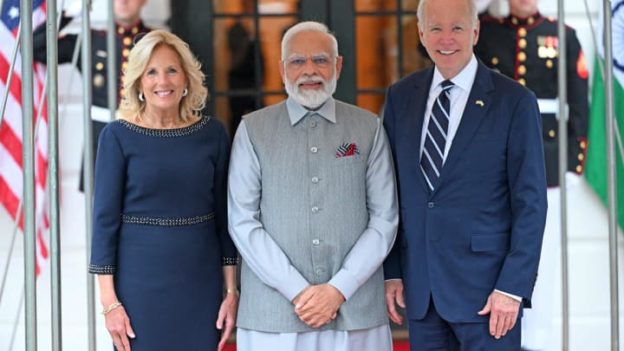For a rapidly growing economy like India, energy security is one of the key areas where it needs to focus in order to achieve its dream of a $10 trillion economy. Despite the most formidable energy crisis looming over the world today, India has managed to navigate its way through its multipronged approach of diversification of energy supplies and tapping the potential of lower to zero-emission energy sources. However, the challenge India faces is not just to work aggressively toward its growth ambitions but also to achieve them in a responsible and sustainable manner.
The United States stands with India resolutely as India paves its way forward to a more sustainable tomorrow. The recent visit of PM Modi and the closeness between the two governments showcases that a lot can be achieved collaboratively in the horizon years toward a greener future. This partnership is of conviction, compassion, and collaboration within specific areas in which energy is one of the most important pillars. India is the world’s third-largest energy-consuming country with 80 percent of its demand still being met by nonrenewable sources.
The current per capita energy consumption of India is 1/3 of the global average and around half the Asian average. The pace of India’s development is only going to double its energy demand by 2040. This is why India needs to tap into alternative energy sources to replace its dependence on non-renewables and switch to cleaner fuels seamlessly without hampering its growth trajectory. The path to clean energy transition has to be smooth and free from technological bumps and breaks. This is why, India must explore all forms of clean energy options from low-emission sources like gas to zero-emission sources like Wind and Solar and Green Hydrogen to fulfill its requirements.
Where US-India stand in energy partnership
During PM Modi’s recent visit to the US, the two governments enhanced their focus on the Strategic Clean Energy Partnership (SCEP) which is a more comprehensive and renewed version of the original Indo-US Energy Dialogue of 2005. The US-India SCEP stands on important pillars like Responsible Oil and Gas, Emerging Fuels, Power and Energy Efficiency, Renewable Energy and Sustainable Growth and is supported by a host of nodal ministries like Petroleum & Natural Gas, Power, New and Renewable Energy and the Niti Ayog.
The main goal of the SCEP revolves around supporting the development and implementation of energy-efficient policies, best practices to achieve energy efficiency goals, and reduction in greenhouse gas emissions. The US Department of Energy (DOE) and India’s Bureau of Energy Efficiency (BEE) are already in the process of working on the sustainable growth of the building sector like the Grid Integrated Efficient Building (GEB) framework and waste heat recovery.
The upcoming areas that are being brought under the SCEP purview include Hydrogen as a potential replacement for fossil fuels, the introduction of biofuels into the value chain, the use of lower emission options like natural gas to bridge India’s de-carbonisation pathway and carbon markets, and energy transition.
The 14th Clean Energy Ministerial happening in Goa next week when the G20 presidency is with India is a crucial stage to help India to push its energy transition ambitions towards reality. The US stands firm on its commitment to support India with technical assistance, aid, and cohesive partnership in the aforementioned areas. Also, it will play an important and leading role in Global Biofuel Alliance that will be announced during CEM.
Conclusion
PM Modi first introduced the concept of One Sun, One World, One Grid back in 2018 at the first assembly of the International Solar Alliance spearheaded by India. The world today is now coming together to align with this while India is already working on introducing a new Global Bio-Fuel Alliance. Initiatives like these have thus placed India in the steering position for the world energy transition scenario.
The partnership between India and the US is a people-to-people link, it is a stepping stone for research and academia to come together and industries supporting and handholding new areas like green hydrogen which is completely new to the world in terms of storage, safety, mobility etc. The partnership will pave the way to not only bring the two great nations closer in their joint commitment towards a more sustainable energy sector but will also help bring other countries who believe in the same future into the realm.
Also read: G20 ministerial meeting: India to sell green hydrogen with carbon credit
All of this sounds exciting but the path ahead is bound to be challenging. The mantra for India should be macro planning and micro implementation which will put the key policy and regulatory aspects to the sub-national level achieving what is needed for the net zero commitments. Financing will be an obstacle to India’s growth trajectory but the same can be addressed by bringing blended financing options including multilateral and bilateral agencies, private sector participation and engaging the community in the project preparation stage for some of the futuristic and large-scale projects.
The G20 Leaders Summit in the second week of September this year will provide a platform to resolve and take the energy transition collaboration to greater heights along with taking key economic and geo-political issues to the next level. The world today is looking towards India and therefore India must put its best foot forward in fulfilling its ambitions in a climate-responsible manner.
https://www.financialexpress.com/economy/taking-the-us-india-partnership-toward-a-greener-future/3181008/





